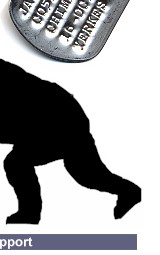






|
||||||||||||||||||||||||||||||||||||||||||||||||||||||||||||||||||||||||||||||||||||||||||||||||||||||||||||||||||||||||||||||||||||||||||||||||||||||||||||||||||||||||||||||||||||||||||||||||||||||||||||||||||||||||||||||||||||||||||||||||||||||
Washington National Primate Research Center If WaNPRC is the last line of information on your Primate Freedom Tag, that means you have a personal connection with a monkey currently imprisoned in Seattle, Washington. According to Paul Robertson, a center administrator, "Research
is done by more that 300 investigators at the University and from
other institutions throughout the U.S.... An international program
includes collaborations with Indonesia and Russia ... the WaRPRC
supports facilities at two locations in Indonesia: a natural habitat
breeding facility on Tinjil Island and at Bogor University in West
Java; as well as at the Institute of Medical Primatology near the
Black Sea in Adler, Russia." The homepage claims, "The Center has about 1,800 monkeys representing
four species. Another 1,400 macaques live in the natural habitat
breeding facility on Tinjil Island in Indonesia," but no mention
is made of West Java or Russia. Institutions such as the WaRPRC are establishing offshore facilities
where oversight is completely impossible and information exceedingly
difficult to obtain. Both Wake Forest University and the Oregon
Regional Primate Research Center are collaborating with WaRPRC in
the Tinjil Island project. “Tinjil Island, a 600 ha island located off the southern
coast of West Java, Indonesia, has been designated a natural habitat
breeding facility (NHBF) for simian retrovirus (SRV)-free longtailed
macaques (Macaca fascicularis)…. Between February 1988 and
December 1994 a total of 520 adult longtailed macaques (58 males
and 462 females) were released onto Tinjil Island which previously
had been uninhabitated by monkeys). Before being released, all animals
were screened for SRV and tuberculosis (TB). The Tinjil population
has been censused annually since 1990. The most recent census data
(1997) indicate the presence of 18-20 social groups located throughout
the island. Estimates of reproduction suggest an annual birth rate
of about 60%. The current population size on Tinjil Island is estimated
to be 1550 macaques. A critical management activity of the NHBF
is the periodic harvesting of offspring for use in biomedical research.
During 13 harvest operations between 1991 and 1997, 707 offspring
(396 males and 311 females), mostly 1 to 3 years old, have been
removed from the island.” Mention must be made of two special programs underway at Washington:
Primate Supply Information Clearinghouse
The Primate Supply Information Clearinghouse (PSIC) is essentially
a swap-meet for primate vivisectors. Primate experimentation tools
and animals are offered for sale, trade, and sometimes free to anyone
willing to pay postage. In one past issue of the newsletter an established
breeding colony of 110 African green monkeys "owned" by
Tulane was offered for sale; three SIV positive Sykes monkeys from
Yerkes were offered, 44 bushbabies including older wild-caputured
animals were offered for $500 each; a number of cynomolgus macaques
were offered from various institutions, an undisclosed number had
been used in prior research. The Oregon Regional Primate Research
Center's listing for rhesus macaques was interesting: "Males,
females, various ages, some prior research, some naive. Pregnant
female from timed mating program, known gestation period available."
Charles Bradbury, apparently from the West Haven, Connecticut VA
Hospital, Department of Psychiatry, was offering two Plas-Labs primate
restraint chairs on casters and in good condition to the highest
bidder. According to William Morton, WaRPRC director, "At the end
of 1998, the PSIC had 479 subscribers and participants. The PSIC
database, maintained on an IBM-compatible PC, includes >600 active
listings for animals, tissues, suppliers, services, equipment, and
other primate resources. In 1998, > 600 referral requests were
received and the PSIC was able to provide an average of five sources
per request. In all, 3,694 animals were placed, with 379 facilities
and >475 researchers, veterinarians, and colony/zoo managers
participating in the network." Another program that sets WaRPRC apart is the Infant
Primate Research Laboratory. Other than the obvious odious nature of an entire lab devoted to
rearing and supplying infant monkeys to researchers, one point of
concern regarding this facility is the fact that it is under the
direction of Gene P. Sackett (Associate Director). Sackett is the
author of papers such as: "The Effects of Total Isolation Rearing
on the Behavior of Rhesus and Pig-tailed Macaques" (1976),
and the recently published "Weaning, Body Weight, and Postpartum
Amenorrhea Duration in Pigtailed Macaques (Macaca nemistrina)."
[Maninger N, Sackett GP, Ruppenthal GC. American Journal of Primatology:
2000 Oct; 52(2):81-91], in which the authors write: "Early
permanent infant separation or weaning decreases the time interval
between pregnancies and interbirth intervals for many female primates." Sackett is a student of the infamous Harry Harlow, and, as such,
has based his career and life on the study of the effects of taking
babies from their mothers. For a more detailed look at the legacy
of Harlow visit: Downstream:
Suffering Harlow. Listed below you'll learn about the experimentation being funded by the National Institutes of Health conducted at the WaNPRC. Most researchers (e-mail addresses provided) are conducting many studies at any one time. It is impossible to keep totally up-to-date on the various experiments being conducted at the Washington Regional Primate Research Center (or any of the other NIH-funded giant primate vivisection facilities around the country). The reason for this is the ungodly amount of money Congress continues to give to these facilities. And, like nearly all recipients of federal tax revenues, they have to keep spending the money to show that they "really" have a need for it. So, more experiments are conceived and begun all the time. Others are abandoned. It's all about money, money, money ...
MICHAEL B. AGY <magy@u.washington.edu>,
SHIU-LOK HU <hus@u.washington.edu>
and LAWRENCE COREY <lcorey@u.washington.edu>
are continuing a ten-years-long series of experiments, infecting
pig-tailed and crab-eating macaques intravenously, intrarectally
and intravaginally with SIV and HIV-1. CHARLES E. ALPERS <calp@u.washington.edu>
In 1998 Alpers was infecting pig-tailed macaques and crab-eating
macaques with SIV, HIV-2, and HIV-l because he wanted to study the
effects of these diseases on the monkeys’ kidneys. Now he
says, "Preliminary studies have shown that a proportion of
macaques, when experimentally infected with HIV2, will develop thrombotic
microangiopathy ... We will define the chronology of this disease
process in infected macaques by means of clinical monitoring of
serum and urine for evidence of organ dysfunction, immunological
abnormalities including those involving lymphocyte subsets, and
serologic evidence of infection. Morphologic correlation will be
established by periodic biopsy and by necropsy studies of relevant
affected organs including heart, lung, brain, and gut." (Meet
Chuck!) DAVID M. ANDERSON <danderso@u.washington.edu>
worked to discover the dose of HIV required to infect female pig-tailed
macaques vaginally and rectally. GAIL D. ANDERSON was culturing macaque adrenal glands,
testes and ovaries obtained from the RPRC Tissue Program to investigate
the effect of antiepileptic drugs on gland produced enzymes. (1998) MARJORIE E. ANDERSON <andermar@u.washington.edu>
discovered, in her attempt to understand brain chemical interactions,
that tubing, surgically embedded in a monkey's brain (species undisclosed),
may cause localized paralysis. Now she is experimenting on monkeys
treated chronically with MPTP, a drug that causes tremors, ridgidity,
lack of balance, and many Parkinson's disease-like symptoms in monkeys.
(Meet
Marjorie!) ROBERT G. ANDREWS is looking for a way to transfer genes between individuals. He is attempting this by transplanting bone marrow between monkeys of some undisclosed species. GREGORY A. BOSCH was trying to determine which minute part
of a staphylococcus bacteria would cause a monkey to vomit and have
diarrhea. (1998) MARNIX L. BOSCH <marnix@u.washington.edu>
discovered a new class of herpes viruses associated with AIDS related
Kaposi 's sarcoma, a type of cancer. Bosch infected four crab-eating
macaques and six rhesus macaques with the new virus. The rhesus
became ill; the crab-eating macaques did not. In a separate study
Bosch infected new-born rhesus orally, intravenously, and rectally
with HIV-1. DOUGLAS M. BOWDEN <dmbowden@u.washington.edu>
In 1998 Bowden surgically installed cranial implants in two monkeys
and tested whether macaques (species undisclosed) learned more rapidly
with a reward of direct electrical stimulation to the medial dorsal
nucleus of the thalamus. Today, Bowden is active in the creation
of the Template
Atlas of the Primate Brain. (Meet
Doug!) JERRY BOOGAARD tested an inner ear implant in monkeys and
Guinea pigs. He said this new device might offered some deaf humans
greater speech discrimination. But such implants were already in
use in humans. WILLIAM J. BREMNER was studying male contraception by recording
the effects of various drugs on the growth of the prostate gland
in castrated monkeys. He seems have given up on monkeys and has
moved on to humans. STEVEN L. BUCK used an "in vitro" preparation
of the macaque retina (species undisclosed) in an attempt to understand
color vision in humans. JOHN A. BUFORD was studying brain/spinal chord interactions
associated with reaching with the hand. THOMAS M. BURBACHER <tmb@u.washington.edu>
"My research program is focused on identifying alterations
in brain development and function due to prenatal exposure to neuroactive
substances. The program is one of only a handful in the country
using nonhuman primates." One must ask what "a handful"
might mean here? There have been at least 117 studies published
since1976 on ethanol or mercury exposure (which is the area of Burbacher's
interest) in animals (mostly monkeys). From 1995 there have been
nearly 2000 published studies on ethanol exposure in utero
in humans and over 400 studies on mercury exposure in humans in
utero. And 123 on methanol in utero exposure. Perhaps
Burbacher means that only a handful of such studies have paid his
salary. (Meet Tom!, Well, actually you can't any more. Tom took
his personal page down some time ago. He is still quite busy however.
He directs the Infant Primate Laboratory and publishes quite frequently
about the many ways one can poison monkeys.) CLARK, EDWARD A. <eclark@bart.rprc.washington.edu>
is attempting to determine whether HIV affects nerve cells in macaques. CLOWES, ALEXANDER W. <clowes@u.washington.edu>
is injuring baboons’ arteries to study arterial grafts. "As
an approach to gene therapy, we are seeding modified smooth muscle
cells into [experimentally] injured arteries and vascular grafts
in several different species (rat, dog, baboon). (Meet
Al!) COREY, LAWRENCE <lcorey@u.washington.edu>is
growing human viruses on monkey kidney tissue. [Evidence suggests
that this same technique is what introduced cancer causing simian
virus 40 (SV-40) and perhaps some unidentified precursor to HIV
into the human population.] DACEY, DENNIS M. <dmd@u.washington.edu> writes, "Detailed knowledge of human retinal cell types is ... extremely limited, lagging far behind a rapidly growing understanding of macaque retinal neurons." So, he explains, "Our experiments are directed at determining which combinations of cell types are responsible for coding information about blue/yellow and red/green channels. We use intracellular recording and imaging in a unique preparation of living retina ..." apparently using rhesus, stump-tailed, and crab-eating macaque retinas. "Our longterm research goal is to characterize the functional organization of the macaque retina as a model for understanding the early stages of the human visual processing." (Meet Dennis!) DILLER, LISA C. is involved in workwith Dacey (above). DUBACH, MARK <mdubach@u.washington.edu>
was hoping to discover an area in a monkey’s brain similar
to an area in a rat’s brain which will cause convulsions
when a particular chemical is injected into it. Now he is working
with Guderson (below). He writes, "In "Limbic Seizures
and Neurobehavioral Development" (V. Gunderson) my principal
role is to arrange for the induction of seizures by focal drug injections
at sensitive sites in the brain. In 1998 we used my curved-injector
technique to treat an extended portion of the entorhinal cortex.
The first acute injection of bicuculline in each of five monkeys
led to seizure activity in the hippocampus within 10-20 min, as
well as acute behavioral signs of complex partial seizures..."
"In "Dopaminergic and GABAergic Actions of Pallidal Discharge"
(M. Anderson) my role has been to implant an access fiber for repeated
drug application throughout several millimeters of the putamen [a
brain region]. A paper describing the method was published in 1998.
In "Neural Substrate of Learning" (D.Bowden), which involves
electrical stimulation of the brain as a reward for learning a visuomotor
task, I am responsible for platform implantations to enable the
targeting of subcortical regions for electrical stimulation. Long-range
plans include the implantation of an access fiber in prefrontal
cortex to examine the effects of drug administration on learning."
(Meet
this piece of scum.) EATON, DAVID L. <deaton@u.washington.edu>
was using non-human primates, probably pig-tailed macaques, to test
whether two different drugs might protect them from the carcinogenic
effects of the fungi Aspergillus flavus and Aspergillus parasiticus,
both common molds in humid tropical climates. He now seems to have
moved on to propagandizing middle school and high school teachers.
(Meet
Dave!) FETZ, EBERHARD E. <fetz@u.washington.edu>
is implanting electrodes in the brains and spinal chords of monkeys
(species undisclosed) and then forcing them to perform various tasks
while he records the electrical variations from the implants. (Meet
Eberhard!) FLICKINGER, CHARLES J. <cjf@virginia.edu>
was using macaque ovaries from WaRPRC to look for a new contraceptive.(1998).
He works at the University of Virginia. (Meet
Charles!) FUCHS, ALBERT F. <fuchs@u.washington.edu>
is placing monkeys (species undisclosed) in some sort of restraint
device and recording the coordination of head On March 18, 2000, Al got pulled over for driving erradically in the Pleasant Hills suburb of Pittsburgh. The police officer smelled alchohol and administered sobiety tests. Al failed and was arrested. He was then asked to submit to a blood test, which he refused. He told the officer that he had a fear of needles. Al's driver's liscence was suspended for a year. Al appealed, but lost his case. [From court records: Commonwealth Court of Pennsylvania No. 246 C.D. 2001.] We wonder where Al got his fear of needles? And what the psychological motivation for experimenting on monkeys strapped into chairs might be for someone with such a fear? GAUR, LAKSHMI <lgaur@u.washington.edu>
is attempting to create diabetes-like symptoms in monkeys. GLEICH, GERALD J. commented, "Although we purify eosinophils
[a type of white blood cell] from human blood on an almost daily
basis, the purification of monkey eosinophils was exceedingly difficult
and we were not able to achieve the degree of homogeneity that we
regularly achieve with human eosinophils." (1998) GLENNY, ROBB W. <glenny@u.washington.edu>
reported, "Three baboons (25.5-27.0 kg) were anesthetized ...
Different colors of fluorescent microspheres ... were injected ...
while the animals were in the supine, prone, head-up (repeated),
and head-down (repeated) postures. After the last microsphere injection,
the animals were killed and their lungs were excised, dried ...
and diced ... We conclude that gravity plays a minor role in determining
pulmonary perfusion heterogeneity in upright primates." (Meet
Robb!) GLOMSET, JOHN A. is studying neurochemicals in an undisclosed
species of monkey. (Meet
John!) GOODMAN, MORRIS <mg@tree.roc.wayne.edu>
has suggested the old world monkeys and new world monkeys are more
distant from an evotutionary perspective than has been thought.
As interesting as such conjectures are, his method of inquiry is
the analysis of certain genes in developing monkey embryos and fetuses
whhic he recieves from WaRPRC. He is on staff at Wayne State. (Meet
Morris!) GREENBERG, PHILIP D. writes, "The studies will be performed
in a non-human primate model with SHIV, a chimeric virus comprised
of elements of HIV-1 GUNDERSON, VIRGINIA M. <gunder@u.washington.edu>
is learning how to bolt the heads of three month-old baby monkeys
into a restraint device and inject chemicals into their brains to
induce seizures. Other than getting to learn a new technique, she
is asking whether seizures might interfere with later neurobehavioral
development in an undisclosed species of monkey. Her university
bio page makes the outlandish claim that her methods are the same
as those "used to study human development." "The primary goal of this research is to develop a macaque
monkey model for complex-partial seizures during the first year
of life....There is concern that early seizures may adversely affect
cognitive and emotional functioning during childhood [in humans].
Cranial assemblies are implanted on project animals using stereotaxic
surgical techniques. In previous years we attempted to induce seizures
by the microinfusion of bicuculline methiodide into an area deep
within the piriform cortex. Unfortunately this procedure was not reliable in obtaining seizures
on a regular basis." Imagine being disappointed because the drug you elect to inject
directly into an infant monkey's brain cause seizures only a part
of the time. "Therefore, we tried two other protocols. First, in four animals we attempted to induce seizures by the infusion of drug into the hippocampus. Again, the results were inconsistent. Second, in another four animals, we induced seizures by infusing drug into the entorhinal cortex. The latter procedure was very successful, and we were able to obtain seizures in every animal on our first attempt." A real life-saving breakthrough. (Meet Virginia! Well, you can't actually. Virginia receieved some negative publicity after this information was published on the Internet and now keeps a very low profile. In fact, she now goes by the name of Virginia Batterson for the classes she teaches at the University of Washington. Maybe she doesn't want her students searching for 'V Gunderson' and finding out that their professor is a monster.) Currently, and what should be ironically, but isn't in the world of primate vivisection, Virginia is a part of the university's Animal Care and Use Committee (IACUC). This means that she gets to decide whether what other researchers are doing, or want to do, to animals should or should not be allowed. What in the world wouldn't Virginia allow to be done to an animal? What a mockery. You can give her a call at: (206) 543-8547. HA, JAMES C. <jcha
@ u.washington.edu> In 1998, Ha, with other members of WaRPRC,
published "Fetal, infant, and maternal toxicity of zidovudine
(azidothymidine) administered throughout pregnancy in Macaca nemestrina."
in the May edition of the Journal of Acquired Immune Deficency Syndrome
and HumanRetrovirology. The abstract for this study is worthy of
scrutiny: "The toxicity of azidothymidine (AZT) was studied in monkey
dams and fetuses that were exposed to the drug over the entire gestational
period. Fourteen virus-free female macaques (Macaca nemestrina)
were randomly assigned to AZT or control groups. AZT animals received
the drug through a gastric catheter at a dose of 1.5 mg/kg every
4 hours, which produced plasma concentrations similar to those in
humans taking 500 to 600 mg/day of AZT. Control animals received
water placebo, also through gastric catheter [a tube implanted into
their stomachs]. Some animals participated in both groups. All females
were mated with the same male; 41 matings produced 20 pregnancies,
of which 16 were carried to term (9 in AZT females; 7 in control
females). The AZT animals developed an asymptomatic macrocytic anemia,
but hematologic parameters returned to normal when AZT was discontinued.
Total leukocyte count decreased during pregnancy and was further
affected by AZT administration. AZT-exposed infants were mildly
anemic at birth. AZT caused deficits in growth, rooting and snouting
reflexes, and the ability to fixate and follow near stimuli visually,
but the deficits disappeared over time. These data indicate that
early exposure to AZT in utero should have no irreversible adverse
effects on the fetus." Compare this with the "Lack
of Long-term Effects ..." and see whether Ha's work was
cited. If it wasn't, it means that Ha's work was ignored by human
clinical researchers. (Meet
James!) HAGOPIAN, WILLIAM A.<wah@u.washington.edu>is
using pig tailed macaques to look for an early, pre-symptom, diagnostic
for diabetes. (Meet
William!) HAIGWOOD, NANCY L.<haigwood@u.washington.edu>
is experimenting with DNA vaccines against SIV. She writes, "5
[out of] 6 macaques infected with pathogenic HIV-2 were protected
from CD4 decline for more than two years after cessation of treatment,
while 6/6 controls suffered decline. Time to disease and time to
death were significantly different in control and treated groups."
Elsewhere, she further explains her reasoning, if not her ethics,
"The models presently under study are non-human primate lentiviruses,
members of the retrovirus family that cause AIDS. In macaque monkeys,
the major viruses are SIV, HIV-2, and recombinant viruses or chimeras
of HIV-1 and SIV, called SHIV viruses. In SIV infection of macaques,
the mean time to disease and death is one year." HENDRICKSON, ANITA E. <anitah@u.washington.edu>
is studying retinal development in pig-tailed macaques. Although
it is unclear, it is possible that Hendrickson is given the eyes
of monkeys killed by other researchers. If this is incorrect, the
monkeys are killed solely to suppy Hendrickson's "needs."
But in her fetal monkey brain labeling study their can be little
doubt regarding her villainy. She writes, "We have obtained
well-labeled monkey fetuses using intravenous injections of 3Hthymidine
(3HT) into the pregnant female on a known day of gestation.... Currently
three series are being collected ... with 4-5 fetuses in each series."
(Meet
Anita!) HERR, JOHN C. <jch7k@virginia.edu>
writes, "The mission of the Center for Recombinant Gamete Contraceptive
Vaccine is to develop and test a safe, effective, reversible contraceptive
vaccine. Emphasis is placed upon a vaccine for females ..."
He will be using monkeys from WaRPRC. (Meet
John!) HULTGREN, SCOTT J. was giving macaques bladder infections.
(1998) HO, RODNEY <rodneyho@u.washington.edu>
writes, "We have made significant progress toward achieving
the first goal by using HIV-2 strain 287, which is highly pathogenic
in the macaque, to infect the unique, chronically catheterized maternal-fetal
macaque model. This HIV-2287-infected maternal-fetal model permits
frequent and simultaneous sampling of maternal blood, fetal blood
and the amniotic fluid in monitoring the immunological and virological
response profiles of the dam and the fetus..." highly pathogenic is the code for a disease that
makes the monkeys deathy ill quite rapidly and always kills them. chronically catheterized is the code for surgically
implanting tubes into various areas, cavities, organs and vessels
of the body. maternal-fetal macaque model is the code for pregnant
mothers and their babies having these chronic catheters sewn
into them so that fluids and measurements could be taken while they
died from the highly pahtogenic virus. (Meet
Rodney!) HU, SHIU-LOK <hus@u.washington.edu> is one of scores of researchers around the country sucking up AIDS research dollars. The perennial claim that studying a different disease (SIV) in a different species (any monkey) is wearing thin. The new tact to attract research bucks is the claim that combining two different diseases, SIV and HIV, into a new-to-the-world disease, SHIV, known nowhere else other than primate vivisection laboratories, will shed light on HIV in humans. As silly as this sounds, primate vivisection supporters in the government continue to throw millions of dollars at this scheme. Washington NPRC Annual Report for 03/04
Home Page | Our Mission | News |